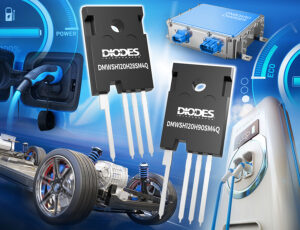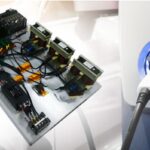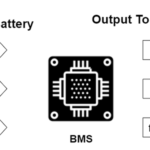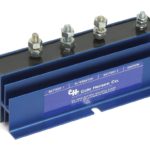 Diodes Incorporated announced a further enhancement of its wide-bandgap product offering with the release of the DMWSH120H90SM4Q and DMWSH120H28SM4Q automotive-compliant Silicon Carbide (SiC) MOSFETs. These N-channel MOSFETs respond to the increasing market demand for SiC solutions that enable better efficiency and higher power density in electric and hybrid-electric vehicle (EV/HEV) automotive subsystems like battery chargers, on-board chargers (OBC), high-efficiency DC-DC converters, motor drivers, and traction inverters.
Diodes Incorporated announced a further enhancement of its wide-bandgap product offering with the release of the DMWSH120H90SM4Q and DMWSH120H28SM4Q automotive-compliant Silicon Carbide (SiC) MOSFETs. These N-channel MOSFETs respond to the increasing market demand for SiC solutions that enable better efficiency and higher power density in electric and hybrid-electric vehicle (EV/HEV) automotive subsystems like battery chargers, on-board chargers (OBC), high-efficiency DC-DC converters, motor drivers, and traction inverters.
The DMWSH120H90SM4Q operates safely and reliably up to 1200VDS with a gate-source voltage (Vgs) of +15/-4V and has an RDS(ON) of 75mΩ (typical) at 15Vgs. This device is designed for OBCs, automotive motor drivers, DC-DC converters in EV/HEV, and battery charging systems.
The DMWSH120H28SM4Q operates at up to 1200VDS, +15/-4Vgs, and has a lower RDS(ON) of 20 mΩ (typical) at 15Vgs. This MOSFET has been designed for motor drivers, EV traction inverters, and DC-DC converters in other EV/HEV subsystems. Low RDS(ON) enables these MOSFETs to run cooler in applications that require high power density.
Both products have low thermal conductivity (RθJC=0.6°C/W), enabling drain currents up to 40A in the DMWSH120H90SM4Q and 100A in the DMWSH120H28SM4Q. They also have fast intrinsic and robust body diodes with low reverse recovery charge (Qrr) of 108.52nC in the DMWSH120H90SM4Q and 317.93nC in the DMWSH120H28SM4Q. This enables them to perform fast switching with reduced power losses.
By using the planar manufacturing process, Diodes has created new MOSFETs that offer more robust and reliable performance in automotive applications—and with increased drain current, breakdown voltage, junction temperature, and power rings as compared to previously released versions. The devices are available in a TO247-4 (Type WH) package, which offers an additional Kelvin sense pin. This can be connected to the source to optimize switching performance, enabling even higher power densities.
The DMWSH120H90SM4Q and DMWSH120H28SM4Q are AEC-Q101 qualified, manufactured in IATF 16949 certified facilities, and support PPAP documentation. The DMWSH120H90SM4Q is available at $18 in 1,000-piece quantities, and the DMWSH120H28SM4Q is available at $38 in 1,000-piece quantities.






Tell Us What You Think!